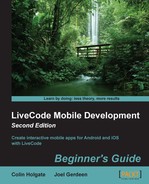For this app, we're going to put some of the logic in the buttons on the cards themselves, but it still leaves a good amount that will have to go into the Stack script. To make it less overwhelming, we'll show one or two functions at a time followed by some explanation about any interesting points in the following steps:
- Open the Stack script.
- Type in the the following handlers:
on openstack if the platform is "iphone" then iPhoneSetKeyboardReturnKey "done" readdata showdata end openstack on returnInField focus on nothing end returnInField
Note
Android OS keyboards generally have a button dedicated to the function putting the keyboard away. On iOS, this isn't the case, as the button that sits where the Return key should be, may have a special word instead, such as Send, or Done. Unfortunately, we are entering text into fields that are able to take a return character. To solve the issue, we set the Return button to say Done, which will lead the user to expect the keyboard to go away when that button is pressed. We will also trap the
returnInFieldmessage and use it as a way to actually put the keyboard away. - Next, type in the functions that will read, and write the list of reminders as a text file to the documents folder on your device:
on writedata global gReminderData put specialFolderPath("documents") & "/reminders.txt" into tRemindersPath if gReminderData is empty then put "no entries yet" into gReminderData open file tRemindersPath write gReminderData to file tRemindersPath close file tRemindersPath clearnotifiers setupnotifiers end writedata on readdata global gReminderData put specialFolderPath("documents") & "/reminders.txt" into tRemindersPath if there is a file tRemindersPath then open file tRemindersPath read from file tRemindersPath until eof close file tRemindersPath put it into gReminderData else open file tRemindersPath write "no entries yet" to file tRemindersPath close file tRemindersPath put "no entries yet" into gReminderData end if end readdataNote
These two functions are using the straightforward ability that LiveCode has to read and write text files. Note that
specialFolderPathis being used to help work out where the file will be saved. This works even when you test on desktop machines. The LiveCode Dictionary shows a full list of special folder paths, including many that don't apply to mobile apps. - You can put the following
showdatafunction into the Home card's Card script as well, but having it in the Stack level keeps it near other functions that are related to it. Type it in now:on showdata global gReminderData go card "home" put empty into field "reminders" put gReminderData into field "data" if gReminderData = "no entries yet" then exit showdata end if set the itemdelimiter to tab put 1 into tLineNumber repeat with a = 1 to the number of lines in gReminderData put line a of gReminderData into tEntry if item 1 of tEntry = "Reminder" then put item 2 of tEntry into tTitle put item 3 of tEntry into tDescription put item 4 of tEntry into tNotificationTime convert tNotificationTime from seconds to abbreviated time and long date put item 5 of tEntry into tLocationName put tTitle & ":" && tDescription && tNotificationTime && tLocationName into line tLineNumber of field "reminders" add 1 to tLineNumber end if end repeat end showdataNote
If you recall the sample text file from earlier, the
showdatafunction takes each line and splits the tab delimited items into chunks of information to present to the user. One cute trick is that the notification time, which is a long number of seconds, is converted into a human-readable form, showing both the date and time of the notification. Thedatafield is used to show the raw data that has been saved. In the final application, you would not show this, but it's handy to check whether the reminder information looks correct or not. - The last functions in the Stack script are used to set up the notifications themselves:
on clearnotifiers mobileCancelAllLocalNotifications end clearnotifiers on setupnotifiers global gReminderData if gReminderData = "no entries yet" then exit setupnotifiers set the itemdelimiter to tab repeat with a = 1 to the number of lines in gReminderData put line a of gReminderData into tEntryDetails if item 1 of tEntryDetails = "Reminder" then put item 2 of tEntryDetails && "-" && item 3 of tEntryDetails into alertBody put "OK" into alertButtonMessage put tEntryDetails into alertPayload put item 4 of tEntryDetails into alertTime put item 6 of tEntryDetails into playSound mobileCreateLocalNotification alertBody, alertButtonMessage, alertPayload, alertTime, playSound end if end repeat end setupnotifiers on localNotificationReceived pMsg answer "Local Notification:" && pMsg end localNotificationReceivedNote
Many mobile apps that use notifications don't ever clear them. In general, maybe they don't need to be cleared. Once they go by, they're gone for good! Well, not always. Sometimes, you'll go into an app just ahead of when a notification comes and you'd do the task, only to then be pestered with notifications about something you already did! In our app, we clear all the notifications that were due and recreate the whole list again. This way, any that you have deleted won't come back to haunt you later. To help in debugging,
alertPayloadis filled in with the entire reminder entry and will be shown to you when the notification comes in.
In addition to getting your fingers nicely warmed up, you entered all the functions to read and write the reminders data and to create and receive the notification messages.
